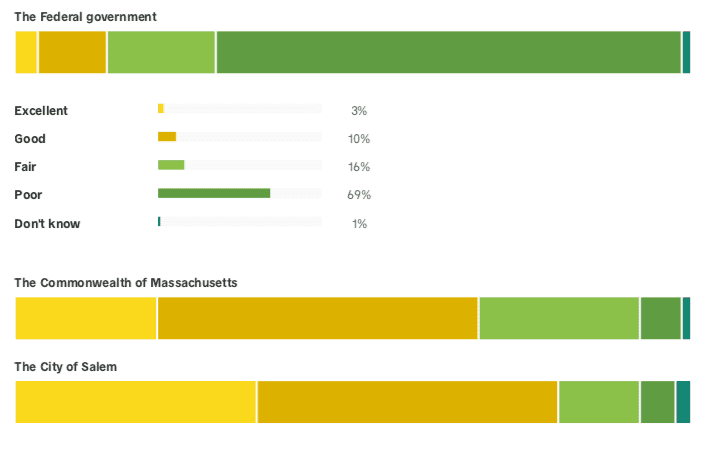SALEM — A survey of Salem residents showed a stark disparity in how they viewed the city’s response to the COVID-19 pandemic compared to that of the federal government.
Of the 2,463 residents who responded to the survey, 81 percent rated Salem’s response to the pandemic to be “excellent” or “good,” while only 13 percent said the same of the administration of former President Donald Trump.
The federal government’s response was considered “poor” by 69 percent of Salem residents, while the city’s response was only considered “poor” by 5 percent of residents.
Also viewed positively was the state response, which was considered “excellent” or “good” by 69 percent of residents surveyed.
“I’m very grateful to the thousands of Salem residents who took the time to share their feedback and thoughts with us as we continue to plan and implement actions to respond to the COVID-19 pandemic,” said Mayor Kimberley Driscoll. “The data from this survey is being closely reviewed by our city’s COVID Response Task Force, and we will develop additional strategies and approaches based on this important information.”
Residents felt the city was doing a “good job” of providing testing opportunities, with 88 percent of respondents reporting that they have generally good access to COVID testing and 85 percent saying that the city is doing an “excellent” or “good job” providing testing opportunities.
The city offers drive-up testing six days a week at Salem High School, 77 Willson St., and walk-up testing at Old Town Hall, 32 Derby Square, five days a week.
A large majority (85 percent) of respondents said the city is doing an “excellent” or “good job” of keeping residents informed during the pandemic, and 73 percent of respondents said the city is doing an “excellent” or “good job” of protecting residents from COVID-19.
The city took a bold approach toward COVID-19 during the Halloween season this year, with Driscoll prohibiting MBTA trains from stopping in town on certain days leading up to the holiday that brings thousands of tourists to Salem each year.
The city also requested that businesses close at 8 p.m. in the weeks leading up to Halloween, and made that request mandatory on Halloween night.
Fines were also tripled on Halloween for all violations of COVID-19 protocols around town.
Those measures severely limited the number of tourists in the city in the weeks leading up to the night of Halloween, which may have been crucial in preventing a massive post-Halloween virus spike.
Salem resident Jimmy McCormack believes that, while the city’s response was better than the nation’s, it still didn’t seem to go far enough to prevent the spread during the tourist season.
“I think the Halloween restrictions were treated more as suggestions that were dependent on people doing the right thing,” said McCormack. “I think a lot of cases could have been prevented by stricter regulations preventing tourist traffic in the first place.”
He said he was hopeful that President Joe Biden’s administration can provide a more robust response to the virus.
Economically, the pandemic has had a significant impact on the city, with 47 percent reporting that COVID-19 has had either a “slight negative” or “major negative” impact on their household income.
One percent of respondents reported that the pandemic has had a “major positive” economic impact on their household income.
The survey also asked respondents whether they were more worried about the economic
impacts of the city staying closed too long or the health impacts of the opening back up too soon, and 79 percent said they were more concerned about the potential negative health impacts from opening the economy too quickly.
In addition, the vast majority of respondents asserted their willingness to get a vaccine when it became available, with 88 percent indicating their plans to get vaccinated with only four percent saying that they were opposed to taking the vaccine.
Eight percent of respondents said that they didn’t know if they would get a vaccine.
The demographics of the survey respondents did not appear to be fully representative of the city at-large, with 92 percent of those surveyed reporting that they were Caucasian, three percent reporting that they identified as Hispanic and 2 percent as Black or African-American.
Census data shows that, in 2018, Caucasians made up about 70 percent of Salem’s population, while Hispanics made up 19.4 percent, and African-Americans about 5 percent.
Guthrie Scrimgeour can be reached at [email protected].

